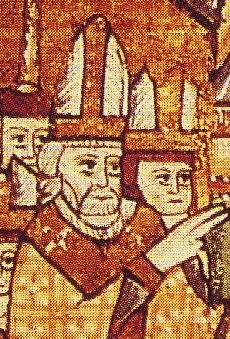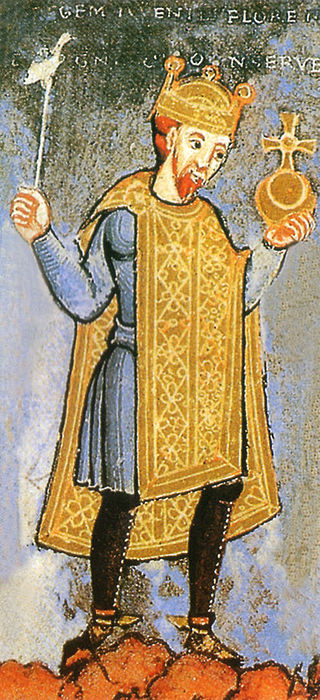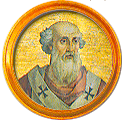Pope Stephen IX was the Bishop of Rome and ruler of the Papal States from 3 August 1057 to his death in 29 March 1058. He was a member of the Ardenne-Verdun family, who ruled the Duchy of Lorraine, and started his ecclesiastical career as a canon in Liège. He was invited to Rome by Pope Leo IX, who made him chancellor in 1051 and one of three legates to Constantinople in 1054. The failure of their negotiations with Patriarch Michael I Cerularius of Constantinople and Archbishop Leo of Ohrid led to the permanent East–West Schism. He continued as chancellor to the next pope, Victor II, and was elected abbot of the Benedictine monastery of Montecassino.

Pope Victor III, was the head of the Catholic Church and ruler of the Papal States from 24 May 1086 to his death. He was the successor of Pope Gregory VII, yet his pontificate is far less notable than his time as Desiderius, the great abbot of Monte Cassino.

Pope Gregory VII, born Hildebrand of Sovana, was head of the Catholic Church and ruler of the Papal States from 22 April 1073 to his death in 1085. He is venerated as a saint in the Catholic Church.
Gregory VIII, born Mauritius Burdinus, was antipope from 10 March 1118 until 22 April 1121.

Guibert or Wibert of Ravenna was an Italian prelate, archbishop of Ravenna, who was elected pope in 1080 in opposition to Pope Gregory VII and took the name Clement III. Gregory was the leader of the movement in the church which opposed the traditional claim of European monarchs to control ecclesiastical appointments, and this was opposed by supporters of monarchical rights led by the Holy Roman Emperor. This led to the conflict known as the Investiture Controversy. Gregory was felt by many to have gone too far when he excommunicated the Holy Roman Emperor Henry IV and supported a rival claimant as emperor, and in 1080 the pro-imperial Synod of Brixen pronounced that Gregory was deposed and replaced as pope by Guibert.
Victor IV was an antipope for a short time, from March to 29 May 1138.

Anselm of Lucca, born Anselm of Baggio, was a medieval bishop of Lucca in Italy and a prominent figure in the Investiture Controversy amid the fighting in central Italy between Matilda, countess of Tuscany, and Emperor Henry IV. His uncle Anselm preceded him as bishop of Lucca before being elected to the papacy as Pope Alexander II and so he is sometimes distinguished as Anselm the Younger or Anselm II.

Jordan I, count of Aversa and prince of Capua from 1078 to his death, was the eldest son and successor of Prince Richard I of Capua and Fressenda, a daughter of Tancred of Hauteville and his second wife, also named Fressenda, and the nephew of Robert Guiscard, duke of Apulia, Calabria, and Sicily. He, according to William of Apulia, "equalled in his virtues both the duke and his father."
Cencio I Frangipane was a Roman nobleman of the Frangipani family of the latter half of the eleventh century. He was a Roman consul
Hugh of Remiremont (c.1020 – c.1099), called Candidus or Blancus (both meaning "the white"), was a medieval cardinal.

The 1088 papal election subsequent to the death of Pope Victor III in 1087 was held on 12 March 1088. Six cardinal-bishops, assisted by two lower-ranking cardinals, elected Cardinal-Bishop of Ostia Odon de Lagery as the new Pope. He assumed the name Urban II.

In the category of the members of the College of Cardinals in the central Middle Ages, an external cardinal a Cardinal of the Holy Roman Church who did not reside in the Roman Curia, because of simultaneously being a bishop of the episcopal see other than suburbicarian, or abbot of an abbey situated outside Rome. In the wider sense, it may also concern cardinals who were appointed to the external episcopal sees and resigned their memberships in the College of Cardinals with this appointment. As well, it can concern cardinals who were generally curial cardinals, but for some time exercised the posts of administrators or prelates of the external churches.

The history of the papacy from 1046 to 1216 was marked by conflict between popes and the Holy Roman Emperor, most prominently the Investiture Controversy, a dispute over who— pope or emperor— could appoint bishops within the Empire. Henry IV's Walk to Canossa in 1077 to meet Pope Gregory VII (1073–85), although not dispositive within the context of the larger dispute, has become legendary. Although the emperor renounced any right to lay investiture in the Concordat of Worms (1122), the issue would flare up again.

The 1118 Papal Election was held to choose the successor for Pope Paschal II, who died in Rome on 21 January 1118, after an 18-year pontificate. Pope Gelasius II was elected as his successor. The election happened during the Investiture Controversy, a conflict between supporters of the Papacy and those of the Holy Roman Emperor. The election was held under the threat of possible violence due to the controversy. The Cardinal electors took refuge in the Benedictine monastery, S. Maria in Pallara, during the election. Within minutes of his election as pope, Gelasius II was attacked and imprisoned by the Frangipani faction, supporters of the Holy Roman Emperor. Gelasius managed to escape, but at the emperor's arrival with his army, he fled Rome and never returned.

The 1099 papal election following the death of Pope Urban II took place on 13 August 1099. Before his death, Urban had designated Cardinal Rainerius da Bieda as his successor. The cardinal-electors, with the consent of the lower Roman clergy, chose Rainerius, who, after a flight and over his considerable objections, accepted and took the name Paschal II. He was consecrated a bishop and crowned pope on the next day.

The Lateran Council of 769 was a synod held in the Basilica of St. John Lateran to rectify perceived abuses in the papal electoral process which had led to the elevation of the antipopes Constantine II and Philip. It also condemned the rulings of the Council of Hieria. It is perhaps the most important Roman council held during the 8th century.

Peter Damian, OSB was an Italian reforming Benedictine monk and cardinal in the circle of Pope Leo IX. Dante placed him in one of the highest circles of Paradiso as a great predecessor of Francis of Assisi and he was declared a Doctor of the Church on 27 September 1828. His feast day is 21 February.

Francesco Sforza (1562–1624) was an Italian cardinal and bishop. He was very influential in a number of conclaves.
Ranulf I was the count of Caiazzo in the Principality of Capua from about 1078. He also brought the formerly Lombard counties of Alife, Telese and Sant'Agata dei Goti and the castles of Airola and Tocco Caudio under his control, dominating the region between Capua and Benevento. He passed this territorial lordship on intact to his heirs, and it remained in their possession until the death of his grandson and namesake, Ranulf II, in 1139.
Beno or Benno, also known as Bruno, was an imperialist Roman Catholic cardinal and priest of Santi Silvestro e Martino ai Monte during the Investiture Controversy. He was one of the bishops who abandoned Pope Gregory VII (Hildebrand) in 1084 and consecrated Antipope Clement III, the candidate of Emperor Henry IV, in Rome. He wrote the Gesta Romanae ecclesiae contra Hildebrandum, an account of the alleged misdeeds of Gregory.












